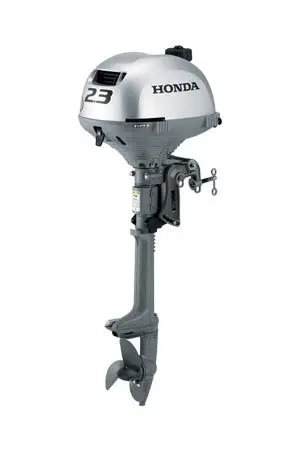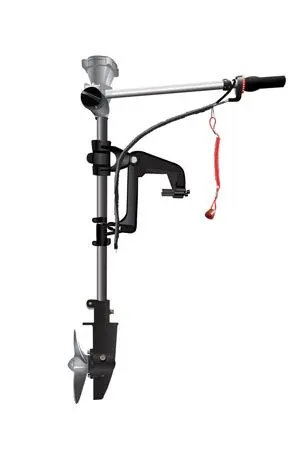
Honda (2.3 hp) Traditional Outboard
- Type 4-Stroke OHV, 1 Cylinder/2 Valves
- Displacement 57.2 cc (3.49 cubic in)
- Full Throttle RPM Range 5,000-6,000 RPM
- Rated Power 2.3 HP (1.7 kW)
- Cooling System Forced Air
- Ignition System Transistorized
- Fuel Unleaded 86 octane
- Fuel Tank Capacity .29 US gal (1.1L)
- Starting System Recoil
- Exhaust Under Water, Above Propeller
- Lubrication Oil Slinger System
- Trim Range 4-Stage: 5°, 10°,15°, 20°
- Tilt Range 75°
- Drive Gear Ratio 2.42:1
- Steering Angle 360° pivot
- Propeller 3-Blade Plastic
- Diameter 7.25 inches
- Transom Height (Non-adjustable)
S Type 418 mm / 16.5 in
L Type 571 mm / 22.5 in
- Dry Weight Engine and Lower Unit / 29.5-31 lbs / Fuel Tank Included Int.
- Tiller Controlled Throttle

Kayak Buddy Standard Engine Leg
The engine leg can accommodate a series of different power-heads and eventually electric.
It has both vertical and horizontal adjustment that far out weigh traditional outboard settings.
Also, it can Interchange props and controls for upgraded power and precision throttle adjustments.

Honda (2.0 hp) Powerhead
- Type 4-Stroke OHV, 1 Cylinder/2 Valves
- Displacement 50 cc (3.3 cubic in)
- Full Throttle RPM Range 6,500-7,000 RPM
- Rated Power 2.0 HP (1.47kW)
- Cooling System Forced Air
- Ignition System Transistorized
- Fuel Unleaded 86 octane and up
- Fuel Tank Capacity .67 US Quart (.63L)
- Starting System Recoil
- Exhaust Above Water, Upward Exit
- Lubrication Oil Slinger System
- With added upgraded engine leg.
- Trim Range 4 Stage: 7°, 14°,21°, 28°
- Tilt Range 75°
- Drive Gear Ratio 2:1
- Steering Angle 360° pivot
- Propeller 2-Blade Aluminum
- Diameter 5.50 inches
- Transom Height
- Adjustable from 15 in. - 23.5 in.
- Dry Weight Engine and Lower Unit / 23 lbs / - Fuel Tank Included Int.
- Tiller Controlled Throttle
